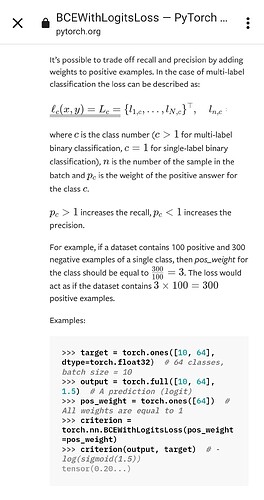I’m working on a binary classification of 446x2048 images, but my test accuracy is stuck at 6% until 1100 epochs in, when it switches to 93%. I’ve tried a few different fixes, but none have worked for me.
Since 6% of my test images are defects and 93% are good, I think after the 1100 epochs the model is just switching from saying everything is a defect to saying everything is not a defect. I have a very limited data set and I cannot obtain more defect images.
Here’s the code:
import os
import torch
import torch.nn as nn
import torchvision
from torchvision import datasets, transforms
from torchvision.transforms import transforms
from torch.utils.data import DataLoader
from torch.optim import Adam
import matplotlib.pyplot as plt
import numpy as np
import torch.nn.functional as F
os.environ["PYTORCH_CUDA_ALLOC_CONF"] = "max_split_size_mb:64"
torch.cuda.empty_cache()
# Loading and normalizing the data.
# Define transformations for the training and test sets
transformations = transforms.Compose([
transforms.ToTensor(),
transforms.Normalize((0.5, 0.5, 0.5), (0.5, 0.5, 0.5))
])
batch_size = 10
number_of_labels = 2
data_dir = "D:/Cropped Copper Plates/Edge Strips"
# Load training data
train_dir = os.path.join(data_dir, "Training")
train_set = datasets.ImageFolder(train_dir, transform=transformations)
train_loader = torch.utils.data.DataLoader(train_set, batch_size=batch_size, shuffle=True, num_workers=0)
# Load testing data
test_dir = os.path.join(data_dir, "Testing")
test_set = datasets.ImageFolder(test_dir, transform=transformations)
test_loader = torch.utils.data.DataLoader(test_set, batch_size=batch_size, shuffle=False, num_workers=0)
print("The number of images in a training set is: ", len(train_loader)*batch_size)
print("The number of images in a test set is: ", len(test_loader)*batch_size)
print("The number of batches per epoch is: ", len(train_loader))
classes = ('Defect', 'No_Defect')
class Network(nn.Module):
def __init__(self):
super(Network, self).__init__()
self.conv1 = nn.Conv2d(in_channels=3, out_channels=16, kernel_size=3)
self.bn1 = nn.BatchNorm2d(16)
self.pool = nn.MaxPool2d(2, 2)
self.conv2 = nn.Conv2d(16, 32, kernel_size=3)
self.drop = nn.Dropout2d()
self.bn2 = nn.BatchNorm2d(32)
self.fc1 = nn.Linear(7187840, 1)
self.fc2 = nn.Linear(512, 2)
def forward(self, x):
x = F.relu(self.bn1(self.conv1(x)))
x = self.pool(x)
x = F.relu(self.bn2(self.drop(self.conv2(x))))
x = self.drop(x)
x = x.view(x.size(0), -1)
#print(x.shape)
x = F.relu(self.fc1(x))
x = F.dropout(x, training = self.training)
#x = self.fc2(x)
return x
# Instantiate a neural network model
model = Network()
# Define the loss function with Classification Cross-Entropy loss and an optimizer with Adam optimizer
loss_fn = nn.BCEWithLogitsLoss()
optimizer = torch.optim.SGD(model.parameters(), lr=0.1, weight_decay=0.0001)
from torch.autograd import Variable
# Function to save the model
def saveModel():
path = "./myFirstModel.pth"
torch.save(model.state_dict(), path)
# Function to test the model with the test dataset and print the accuracy for the test images
def testAccuracy():
model.eval()
accuracy = 0.0
total = 0.0
with torch.no_grad():
for data in test_loader:
images, labels = data
device = torch.device("cuda:0" if torch.cuda.is_available() else "cpu")
images, labels = images.to(device), labels.to(device)
images = images.float()
labels = labels.float()
# run the model on the test set to predict labels
outputs = model(images)
# the label with the highest energy will be our prediction
_, predicted = torch.max(outputs.data, 1)
total += labels.size(0)
accuracy += (predicted == labels).sum().item()
# compute the accuracy over all test images
accuracy = (100 * accuracy / total)
return(accuracy)
# Training function. We simply have to loop over our data iterator and feed the inputs to the network and optimize.
def train(num_epochs):
best_accuracy = 0.0
# Define your execution device
device = torch.device("cuda:0" if torch.cuda.is_available() else "cpu")
print("The model will be running on", device, "device")
# Convert model parameters and buffers to CPU or Cuda
model.to(device)
for epoch in range(num_epochs): # loop over the dataset multiple times
running_loss = 0.0
running_acc = 0.0
for i, (images, labels) in enumerate(train_loader, 0):
# get the inputs
images = Variable(images.to(device))
labels = Variable(labels.to(device))
# zero the parameter gradients
optimizer.zero_grad()
# predict classes using images from the training set
outputs = model(images)
#labels = labels.type(torch.FloatTensor)
#labels = labels.reshape((labels.shape[0], 2))
labels = labels.unsqueeze(1)
labels = labels.float()
outputs = outputs.float()
# compute the loss based on model output and real labels
loss = loss_fn(outputs, labels)
# backpropagate the loss
loss.backward()
# adjust parameters based on the calculated gradients
optimizer.step()
# Let's print statistics for every 1,000 images
running_loss += loss.item() # extract the loss value
if i % 100 == 99:
# print every 100 (twice per epoch)
print('[%d, %5d] loss: %.3f' %
(epoch + 1, i + 1, running_loss / 100))
# zero the loss
running_loss = 0.0
# Compute and print the average accuracy fo this epoch when tested over all 10000 test images
accuracy = testAccuracy()
print('For epoch', epoch+1,'the test accuracy over the whole test set is %d %%' % (accuracy))
# we want to save the model if the accuracy is the best
if accuracy > best_accuracy:
saveModel()
best_accuracy = accuracy
# Function to show the images
def imageshow(img):
img = img / 2 + 0.5 # unnormalize
npimg = img.numpy()
plt.imshow(np.transpose(npimg, (1, 2, 0)))
plt.show()
# Function to test the model with a batch of images and show the labels predictions
def testBatch():
# get batch of images from the test DataLoader
images, labels = next(iter(test_loader))
# show all images as one image grid
#imageshow(torchvision.utils.make_grid(images))
# Show the real labels on the screen
print('Real labels: ', ' '.join('%5s' % classes[labels[j]]
for j in range(batch_size)))
# Let's see what if the model identifiers the labels of those example
outputs = model(images)
# We got the probability for every 10 labels. The highest (max) probability should be correct label
_, predicted = torch.max(outputs, 1)
# Let's show the predicted labels on the screen to compare with the real ones
print('Predicted: ', ' '.join('%5s' % classes[predicted[j]]
for j in range(batch_size)))
if __name__ == "__main__":
# Let's build our model
train(2000)
print('Finished Training')
# Test which classes performed well
testAccuracy()
# Let's load the model we just created and test the accuracy per label
model = Network()
path = "myFirstModel.pth"
model.load_state_dict(torch.load(path))
# Test with batch of images
testBatch()
